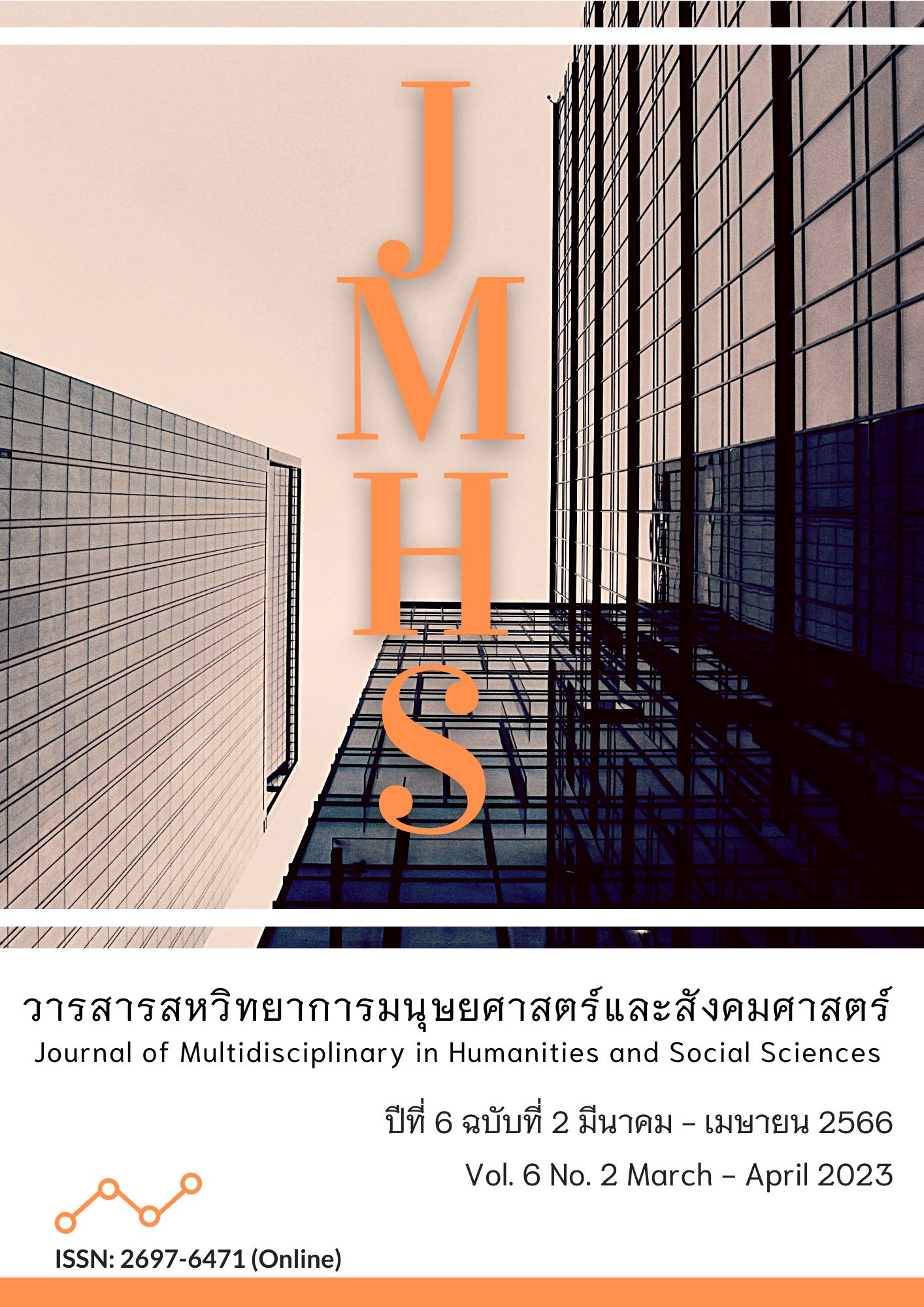The Capitals of Border Petty Traders at the Checkpoint for Border Trade on Thailand-Laos Border
Main Article Content
Abstract
This article focused on the utilization of capital by petty traders at the Thai-Lao trading checkpoint for the Thailand-Lao PDR border. The content of this article was based on qualitative research. Gather data from documents and do field research in Tha Uthen Subdistrict Municipality, the research area was one of the Thai-Laos border trade checkpoints. Nakhon Phanom Province, Tha Uthen District In-depth interviews and participant and non-participant observation among the key informants identified 30 small border traders who have been trading along the research region's border for more than a year. The snowball technique and key informant selection were used. The data were examined using content analysis. According to the findings of the study, petty border traders use three types of capital: 1) economic capital in the form of money or assets used to invest in trade and make profits; 2) social capital in the form of skills; 3) cultural capital in the form of the historical background of cross-border trade along the Mekong River; and 4) symbolic capital in the form of a social position. Acceptance Including the person's power, and so on. Aside from the utilization of capital in various forms. The small border traders can also transform social capital into symbolic capital and economic capital. The findings of the study represent the utilization of capital in various settings and contexts.
Article Details

This work is licensed under a Creative Commons Attribution-NonCommercial-NoDerivatives 4.0 International License.
Views and opinions appearing in the Journal it is the responsibility of the author of the article, and does not constitute the view and responsibility of the editorial team.
References
กรมการค้าต่างประเทศ. (2563). คู่มือการค้าชายแดนกับประเทศเพื่อนบ้าน. กรุงเทพฯ: กรมการค้าต่างประเทศ กระทรวงพาณิชย์.
จักรกริช สังขมณี. (2551). พรมแดนศึกษา และมานุษยวิทยาชายแดน: การเปิดพื้นที่ สร้างเขตแดน และการข้ามพรมแดนความรู้. วารสารสังคมศาสตร์, 20(2), 209-266.
จักรกริช สังขมณี. (2559). พรมแดนของวิธีวิทยา/วิธีวิทยาที่พรมแดน. วารสารสังคมวิทยมานุษยวิทยา, 31(1), 2-22.
จักรพันธ์ ขัดชุ่มแสง. (2563). แม่สอด เชียงของ เศรษฐกิจ การพัฒนา และชีวิตของผู้คนในพื้นที่ชายแดนไทย-พม่า-ลาว. ใน วสันต์ ปัญญาแก้ว (บรรณาธิการ). เชียงใหม่: วนิดาการพิมพ์.
ชาย โพธิสิตา. (2552). ศาสตร์และศิลป์แห่งการวิจัยเชิงคุณภาพ. กรุงเทพฯ: อมรินทร์พริ้นติ้ง แอนด์ พับลิชชิ่ง.
นิลวดี พรหมพักพิง และคณะ. (2563). ผู้หญิง ชาติพันธุ์ ผู้ค้ารายย่อยในตลาดนครพนม. กรุงเทพฯ: สำนักงานคณะกรรมการส่งเสริมวิทยาศาสตร์วิจัยและนวัตกรรม.
บุศรินทร์ เลิศชวลิตสกุล. (2561). พื้นที่กฎเกณฑ์ การต่อรองและการเปลี่ยนแปลงความหมายของสินค้าในการค้าข้ามพรมแดนไทย-เมียนมา. วารสารสังคมศาสตร์, 30(2), 137-176.
ประสิทธิ์ ลีปรีชา และสงกรานต์ จันต๊ะคาด. (2561). การค้าชายแดนกับความ (ไม่) มั่นคงในชีวิตมนุษย์พื้นที่ชายแดนบ้านฮวก. วารสารสังคมศาสตร์, 30(2), 15-55.
ปิ่นแก้ว เหลืองอร่ามศรี. (2559). ปัจฉิมบท: พรมแดนของวิธีวิทยา วิธีวิทยาที่พรมแดน. วารสารสังคมวิทยามานุษยวิทยา, 35(1), 198-211.
พฤกษ์ เถาถวิล และเนตรดาว เถาถวิล. (2561). “ในระบบ” หรือ “นอกระบบ” พลวัตและความกำกวมของการค้าชายแดนในพื้นที่ชายแดนไทย – ลาว. วารสารสังคมศาสตร์, 30(2), 53-96.
พฤกษ์ เถาถวิล. (2552). พื้นที่ของการดำรงชีวิตในการค้าชายแดน: เขตแดนรัฐ พื้นที่ในระหว่างภูมิศาสตร์แห่งการครอบงำ/ต่อต้าน. วารสารศิลปศาสตร์, ฉบับพิเศษ, 19-68.
ยศ สันตสมบัติ. (2555). ชนชายแดนกับการก้าวข้ามพรมแดน. เชียงใหม่: มหาวิทยาลัยเชียงใหม่.
อรรคณัฐ วันทนะสมบัติ. (2561). พลวัตทางการเมืองกับการค้าชายแดนไทย-เมียนมา ที่แม่สอดจากยุคเศรษฐกิจมืดถึงเขตเศรษฐกิจพิเศษ. วารสารสังคมศาสตร์, 30(2), 15-51.
อรัญญา ศิริผล. (2555). ผู้ค้าจีนในชายแดนลุ่มน้ำโขง: เปิดเบื้องหลังการอพยพของคนจีนรุ่นใหม่เข้าสู่ชายแดนลุ่มน้ำโขง. เชียงใหม่: คณะสังคมศาสตร์ มหาวิทยาลัยเชียงใหม่.
อรัญญา ศิริผล. (2561). ผู้ประกอบการจีนรุ่นใหม่กับการเปลี่ยนวัฒนธรรมการค้าชายแดนภาคเหนือไทย. วารสารศิลปศาสตร์, 14(2), 139-157.
Appadurai, A. (2014). Interview: Arjun Appadurai. Globalizations, 11(4), 481–490. https://doi.org/10.1080/14747731.2014.951209
Bourdieu, P. (1997). The forms of Capital. In Education: Culture, Economy and Society, edited by Halsey, Albert Henry, (pp. 241-258). Oxford: Oxford University Press.
Egbert, H. (2006). Cross-border Small-scale Trading in South-Eastern Europe: Do Embeddedness and Social Capital Explain Enough?. International Journal of Urban and Regional Research, 30(2), 346-361. https://doi.org/10.1111/j.1468-2427.2006.00668.x
Elsing, S. (2019). Navigating Small-Scale Trade Across Thai-Lao Border Checkpoints: Legitimacy, Social Relations and Money. Journal of Contemporary Asia, 49(2), 216–232. https://doi.org/10.1080/00472336.2018.1551559
Gomez, Jr., José, E., Nittana, S., John, W., & Samuel, S. (2011). Reaching across the Mekong: Local Socioeconomic and Gender Effects of Lao-Thai Cross border Linkages. Journal of Current Southeast Asian Affairs, 30(3), 3-25. Retrieved from http://journals.sagepub.com/ doi/pdf/10.1177/186810341103000301
Krainara, C, & Jayant, K. R. (2015). Cross-Border Trades and Commerce between Thailand and Neighboring Countries: Policy Implications for Establishing Special Border Economic Zones. Journal of Borderlands Studies, 30(3), 345-363. https://doi.org/10.1080/08865655.2015. 1068209
Laungaramsri, P. (2012). Frontier capitalism and the expansion of rubber plantations in southern Laos. Journal of Southeast Asian Studies, 43(3), 463–477. https://doi:10.1017/S00224634 12000343.
Lertchavalitsakul, B. (2015). Shan Women Traders and Their Survival Strategies on the Myanmar–Thailand Borderland. Sojourn: Journal of Social Issues in Southeast Asia, 30(3), 675-709. https://doi.org/10.2307/24779766
Rattanasuteerakul, K. (2019). Traditional Customs: Mechanism/Network and Relationship System in Managing Transnational Workers of Local Communities. Mekong-Salween Civilization Studies Journal, 10(2), 35-58. Retrieved from https://so04.tci-thaijo.org/index.php/jnuks/article/view/107185/149949
Rowedder, S. (2020). I Didn’t Learn Any Occupation, So I Trade. Sojourn: Journal of Social Issues in Southeast Asia, 35(1), 31-64. https://doi.org/10.2307/26883615
Sangkhamanee, J. (2006). Border River Community “At Large”: Mobility and Identity Construction of the Long-Distance Mekong Boat Traders. In: The regional seminar “Regionalization of Development: Redefining Local Culture, Space and Identity in the Mekong Region. Luang Prabang”, Lao PDR.
Walker, A. (2009). Conclusion: Are the Mekong Frontiers Sites of Exception? In On the Borders of State Power: Frontiers in the Greater Mekong Sub-Region, edited by Gainsborough, Martin, (pp. 101–111). London: Routledge.
Wilson, T., & Donnan, H. (1998). Border Identities: Nation and State at International Frontiers. Cambridge: Cambridge University.


